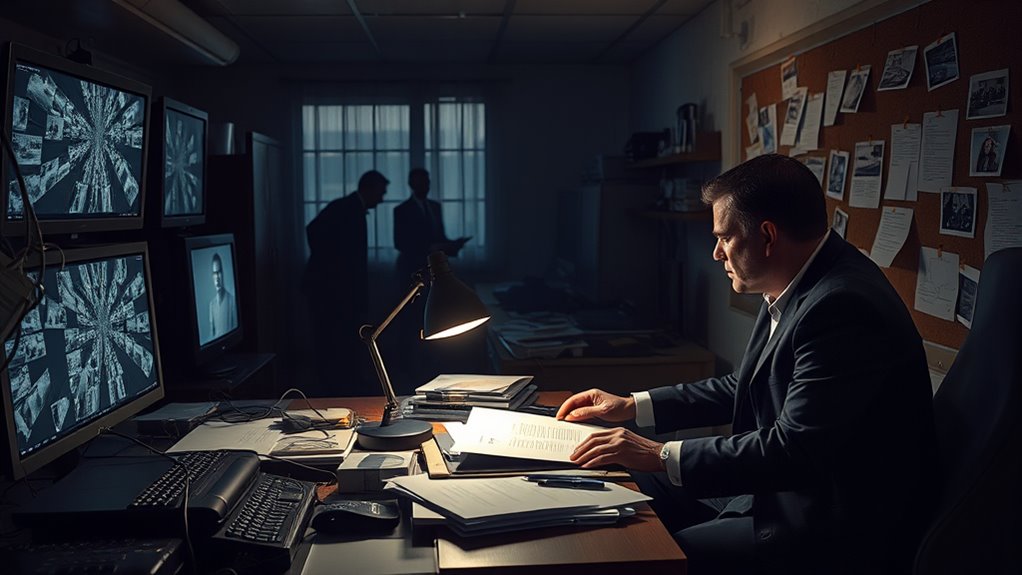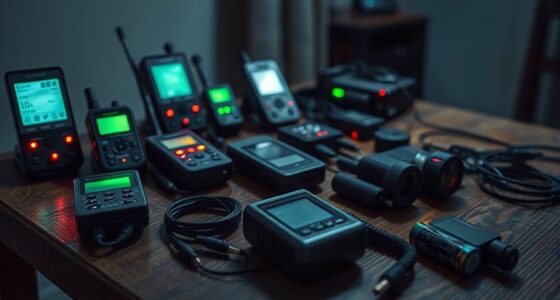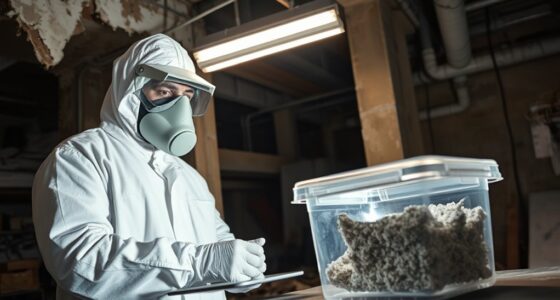Behind the scenes of an investigation, you see careful evidence collection, covert surveillance, and team coordination, but much happens out of sight. Investigators handle evidence meticulously, follow strict legal and ethical rules, and adapt strategies when surprises arise. They use advanced technology to analyze data and digital footprints, all while maintaining focus and flexibility. If you want to uncover more about what truly goes into solving cases behind closed doors, keep exploring further.
Key Takeaways
- Investigators meticulously collect, document, and preserve physical and digital evidence while maintaining a strict chain of custody.
- Undercover surveillance and stealth techniques require careful planning, blending into environments, and reading subtle behavioral cues.
- Effective teamwork, clear communication, and flexible strategies are crucial when facing unexpected obstacles or dead ends.
- Advanced technology, such as forensic software and digital footprints, accelerates data analysis and uncovers hidden connections.
- Behind-the-scenes work involves balancing legal and ethical considerations, avoiding shortcuts, and continuously reassessing investigative approaches.
Gathering and Analyzing Evidence

Have you ever wondered how investigators turn scattered clues into a clear picture? It all starts with careful evidence preservation. You’ll see them meticulously collect and secure every piece of physical evidence, ensuring it remains uncontaminated. Once preserved, forensic analysis kicks in—scientists examine fingerprints, DNA, fibers, and other traces to identify suspects or reconstruct events. You may think evidence just gets taken to a lab, but every step is deliberate to maintain its integrity. Proper collection and handling prevent contamination or loss, which could jeopardize the case. This meticulous process also involves proper storage to prevent deterioration of evidence over time. This process transforms raw clues into reliable data, forming the foundation for building a solid case. Additionally, understanding self-watering plant pots can help prevent overwatering and root rot, ensuring healthy growth—paralleling how careful evidence handling preserves the integrity of a case. The chain of custody is crucial in tracking evidence’s history and ensuring its admissibility in court. Maintaining a clear evidence trail is essential for transparency and accountability throughout the investigation. It’s a meticulous dance of preserving and analyzing that often goes unseen but is critical to justice. Moreover, the importance of evidence integrity cannot be overstated, as it ensures the credibility of the entire investigation process.
Conducting Interviews and Surveillance

When conducting interviews, you need to use effective techniques to gather accurate information without alerting your subject. Stealth surveillance requires careful planning and strategic execution to observe behaviors unnoticed. Mastering these methods is essential to uncovering the truth while maintaining your cover. Understanding the importance of reconnaissance in ethical hacking can also help plan your approach and anticipate potential obstacles before executing your plan. Additionally, familiarity with vehicle tuning methods, such as ECU remapping or suspension upgrades, can sometimes provide insights into a subject’s vehicle modifications that may be relevant during surveillance. Recognizing emotional support needs can further aid in understanding behavioral patterns and responses during interactions, especially when considering auditory processing challenges that might affect communication. Being aware of Frozen Delights trends, like popular frozen yogurt flavors and local shops, can also help you identify areas where subjects might frequent or gather.
Interview Techniques and Challenges
What makes conducting interviews and surveillance particularly challenging is the need for adaptability and keen intuition. During undercover operations, you must quickly read people and adjust your approach based on interview psychology. Recognizing subtle cues, such as body language or tone shifts, can reveal truth or deception. You need to maintain control, build rapport, and extract information without alerting the subject. Challenges arise when the subject becomes defensive or suspicious, forcing you to switch tactics on the fly. Successful interview techniques involve active listening, strategic questioning, and reading between the lines. Surveillance adds another layer of difficulty, requiring you to stay alert and responsive while remaining inconspicuous. Mastering these skills ensures you gather crucial intel without compromising the investigation. Being aware of Pimple Patch technology and ingredients can also help in understanding how certain products work to treat skin issues discreetly and effectively. Additionally, understanding product shelf life and storage can be vital when evaluating the credibility of evidence or suspect claims during an investigation. Staying informed about AI Security vulnerabilities and ongoing safety measures can further enhance your ability to anticipate and counteract potential digital threats during investigations. Developing an understanding of security protocols can also assist in maintaining operational integrity and confidentiality. Furthermore, having knowledge of essential oils and their properties can sometimes aid in discreet communication or stress relief during covert operations.
Stealth Surveillance Strategies
Mastering stealth surveillance requires more than just keen observation; it demands meticulous planning and seamless execution. You must blend into the environment, using undercover operations to get close without detection. Covert communications keep your team synchronized, avoiding suspicion. To stay effective, adapt your approach based on the target’s behavior. Use disguises, vary routes, and choose vantage points carefully. Incorporating cultural adaptations into your strategy can enhance success, especially in areas where Western influences are limited.
Navigating Legal and Ethical Boundaries

Navigating legal and ethical boundaries is vital for maintaining the integrity of an investigation. You must understand legal boundaries to avoid infringing on privacy rights or violating laws like wiretapping or trespassing. Ethical considerations also play a crucial role; you’re expected to act with honesty, respect for others, and fairness. Cutting corners or using questionable tactics can jeopardize your case and damage your reputation. Always double-check whether your methods are lawful and align with professional standards. Remember, your goal is to gather evidence legitimately while respecting individual rights. Staying within these boundaries not only protects you legally but also ensures your investigation remains credible and ethically sound. This balance is essential for credible, responsible investigative work.
Collaborative Efforts and Team Dynamics

Effective investigations rely heavily on teamwork, as collaboration enhances the efficiency and scope of your efforts. When working together, you must keep case file organization tight—imagine a neatly stacked set of folders, each labeled and cross-referenced. Clear team communication strategies are your backbone; picture team members exchanging essential information through concise updates, calls, or instant messages. To succeed, focus on these key elements:
- Coordinated case file organization to avoid missing crucial evidence
- Regular, structured team communication to keep everyone aligned
- Defined roles to leverage each member’s strengths effectively
Handling Unexpected Twists and Dead Ends

When unexpected twists or dead ends occur during an investigation, staying adaptable is crucial. Unexpected setbacks can challenge your progress and force you to rethink your approach. Sometimes, leads turn cold, or evidence vanishes unexpectedly, requiring quick adjustments. Investor pressure can add stress, pushing you to deliver results despite obstacles. To handle this, stay calm and evaluate your options objectively. Reassess your strategy, explore alternative angles, and leverage other sources of information. Remember, setbacks are part of the process; they often lead to new insights. Maintaining flexibility and a problem-solving mindset helps you navigate through dead ends and unexpected twists, ensuring you keep moving forward without losing focus or momentum.
The Role of Technology in Modern Investigations

Technology has revolutionized modern investigations by providing tools that enhance accuracy, speed, and scope. Forensic software now allows you to analyze vast amounts of data quickly, uncovering hidden connections. Digital footprints—like social media activity, GPS logs, and browsing history—help you trace a suspect’s movements and interactions. With these tools, you can:
- Examine digital evidence with precision using advanced forensic software.
- Track online activity through digital footprints to build timelines.
- Access real-time data for faster decision-making.
These technologies enable investigators to piece together complex cases more efficiently. They turn what used to take weeks or months into a matter of days or hours, making investigations more effective and thorough.
Frequently Asked Questions
How Do Investigators Decide Which Leads to Pursue First?
You decide which leads to pursue first by analyzing the case file thoroughly and prioritizing based on potential new evidence. Investigators use interview techniques to gather vital information and verify tips. You focus on leads that seem most promising or urgent, ensuring you’re not wasting time on dead ends. This strategic approach helps you narrow down suspects and build a solid case efficiently.
What Personal Risks Do Investigators Face During Covert Operations?
During covert operations, you face personal risks like dangerous encounters with suspects or hostile environments, which could lead to injury or worse. You also experience psychological stress from maintaining secrecy and constant vigilance. These dangers require you to stay alert, manage fear, and adapt quickly. The stakes are high, and your mental resilience is tested daily, making your safety and well-being a top priority in such risky, undercover missions.
How Do Investigators Handle Confidentiality and Protect Sources?
Think of confidentiality protocols like a vault protecting precious gems—you’d guard it fiercely. You handle informant protection by encrypting communications and using secure channels. You also follow strict procedures to anonymize sources, ensuring their safety. For example, during a recent case, I personally verified the identity of an informant through multiple layers of security. This dedication keeps sources safe and maintains the integrity of your investigation.
What Training Is Required to Become a Professional Investigator?
To become a professional investigator, you typically need training in surveillance techniques and evidence analysis. You should pursue relevant certifications or degrees in criminal justice or law enforcement. Hands-on experience through internships or on-the-job training helps develop your skills. You’ll learn to gather and analyze evidence effectively while maintaining confidentiality. Continuous education keeps you updated on new methods, ensuring you’re well-prepared to handle complex investigations confidently.
How Are Investigators Compensated for Their Work?
Imagine you’re an investigator earning through a mix of compensation structures. Typically, your earnings come from salaries, hourly wages, or project-based fees. For example, in a theft case, you might be paid a set fee for your investigation or an hourly rate for each hour worked. Investigator earnings vary based on experience, specialization, and case complexity, with some earning a steady income while others thrive on high-profile investigations.
Conclusion
So, next time you watch an investigation on TV, remember it’s not all glamorous fame and quick solves. Behind the scenes, you’re dealing with endless dead ends, legal hoops, and tech mishaps. The truth is, real investigations are messier, more tedious, and way less dramatic than they seem. Ironically, it’s often those boring, unspectacular moments that crack the case—yet you rarely see them on screen. Guess that’s the real drama.









